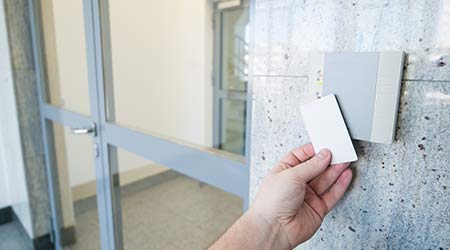Access Control Key to Facility Safety and Security
Part one of a three-part article on access control
The need for security in institutional and commercial facilities continues to attract a great deal of attention, and it has led to a greater reliance on advanced access control systems. While maintenance and engineering managers have realized security benefits from this technology, its impact on facilities goes far beyond simply improving the level of security within buildings.
In many cases, a well-designed and implemented system has resulted in reduced operating and maintenance costs, due in part to hardware standardization and the elimination of traditional key-based systems.
But access-control systems are not maintenance-free. As with all building systems, access-control technology requires comprehensive maintenance, testing, and inspection of key door hardware components in order to ensure it performs as intended. If technicians do not perform those activities regularly, system integrity deteriorates, jeopardizing facility security and increasing maintenance costs.
By streamlining and fine-tuning their departments’ installation, inspection and maintenance activities related to locks, hinges, handles, controls, and other access-control components, managers can ensure that newly specified products provide the security benefits and long-term performance that facilities require.
Looking for trouble
Due to general wear and tear from regular use and abuse, most door-hardware components require maintenance at some point in their performance lives. The most common types of repairs for door-hardware components include lubrication, adjustment, alignment and weather sealing.
Technicians should lubricate key components once every six months to a year, depending on door type and use level. Hinges and door closers might require a few drops of penetrating oil at the top so it runs down into the wearing surface between the pin and the housing. On lock mechanisms that require lubricant, technicians can use dry graphite from a spout-type bottle. This step prevents freezing of door hardware in cold weather, besides simply providing lubrication.
The most effective time to schedule lubrication is just before cold weather arrives. But technicians should not lubricate electronic locks because graphite is an insulator and will interfere with the current flowing through the contacts.
Hinges and closers are the two parts of doors that most often require adjustment, so while lubricating door hardware components, technicians should ensure that hinge screws are tight. Wood door frames can dry out, and screw holes can open up, allowing the screw to continue turning. To address this issue, technicians can fill the hole with a hardening filler, redrill the hole, and either replace the screw or place a screw insert in the hole, then replace the screw.
Related Topics:















